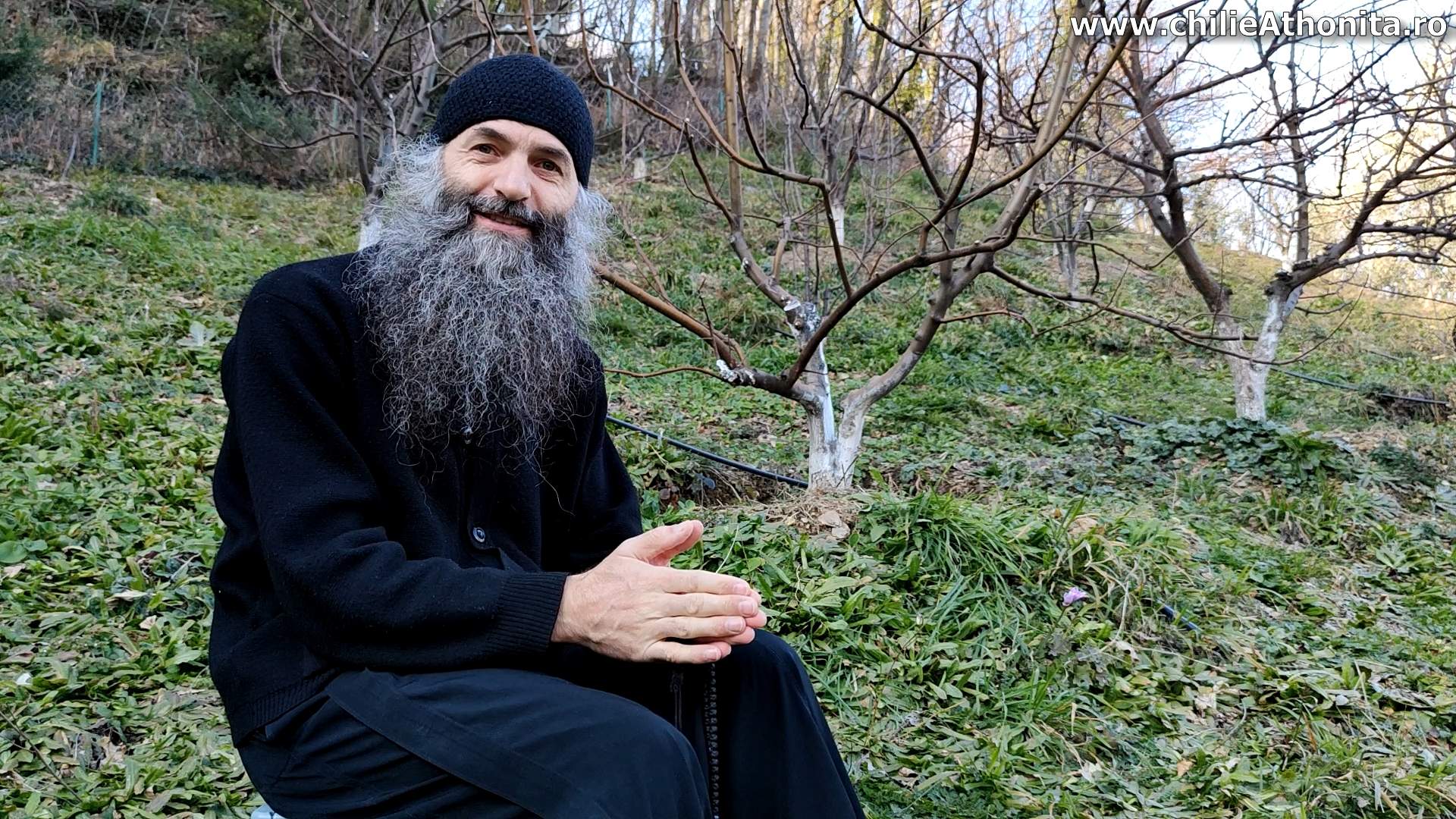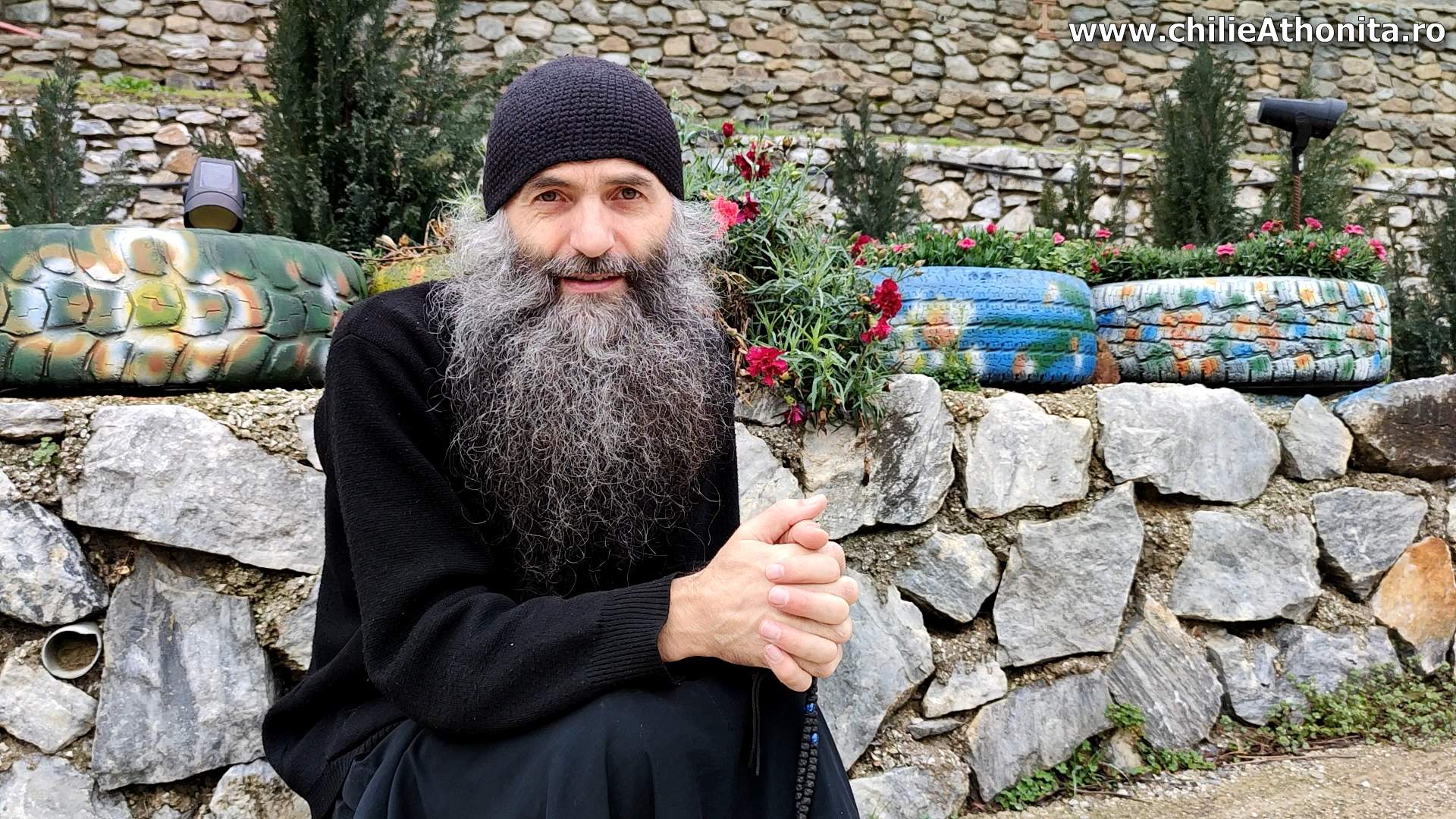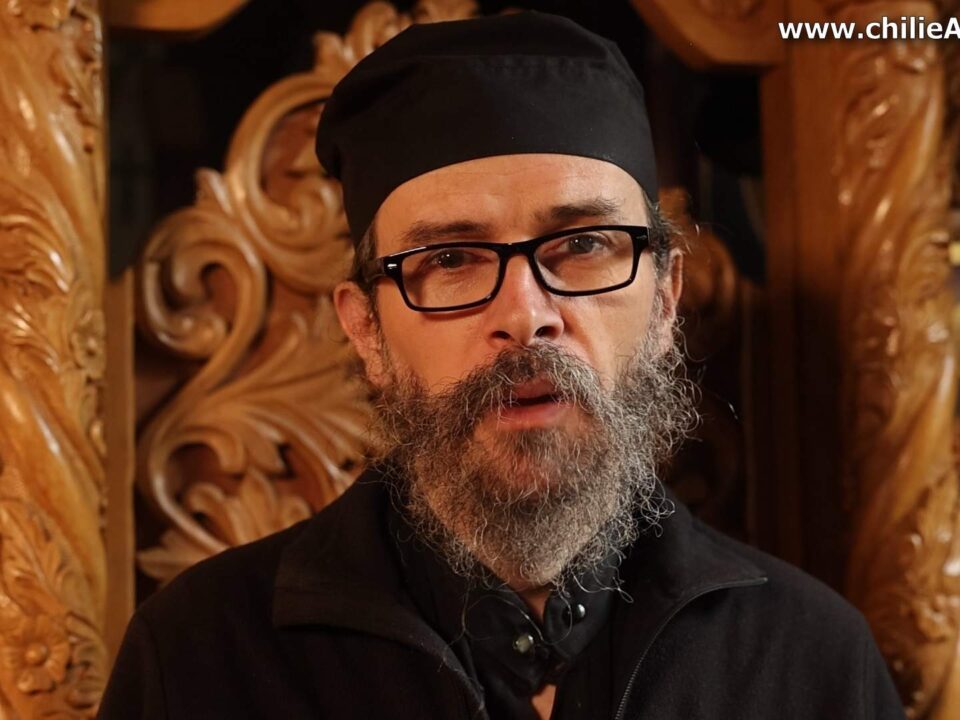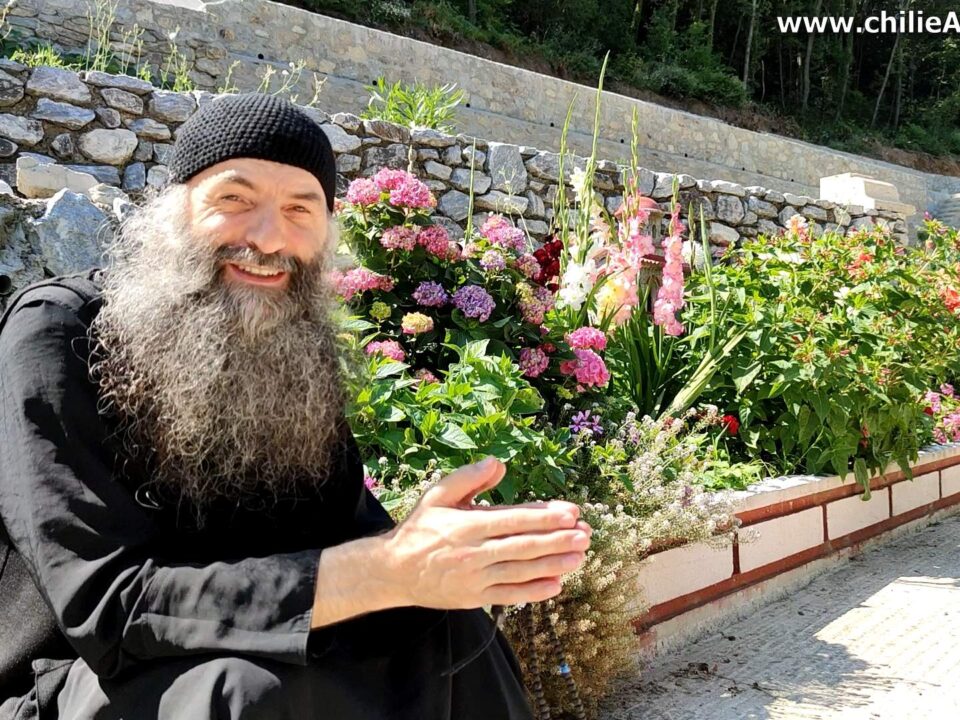
Great Lent – Father Pimen Vlad
23 February 2023
The Joy of Fasting – Father Pimen Vlad
9 March 2023Listen to Father Pimen as he tells us the life of an extraordinary saint – Saint Gerasimus of the Jordan, a life in which we can see the beauty and extraordinary simplicity of the passionless man who resembles Adam before the fall, who commanded the animals.
Enjoy!
We meet again, my dear one ones. Lent has begun, everyone knows better what they’ve done, how they struggled, whether they’ve started fasting with zeal, or changed something for the better in their lives, everyone’s conscience can tell. We talked last week about preparing for Lent, now we’re into it. You know how it is: the more we fight, the more we struggle, the more we will be rewarded, more beautifully, better, by God, by His grace.
What am I thinking about now? Since March 4 is [the feast day of] Saint Gerasimus of the Jordan, let me tell you a few words about him. He was born somewhere in Lycia, in today’s Turkey, and from there he thought of becoming a monk. He went to Thebaid, in Egypt – in that area with many saints at that time, with great ascetic people – he became a monk and he practiced ascesis there for a while.
After that, he returned to his homeland again. He stayed for a while, and from there he went to Palestine and founded a monastery, near the Jordan river. Those of you who have been to Jerusalem, you know the monastery of St. Gerasimus, which has a lion made of brass at the gate, you may have been there and seen it.
St. Gerasimus lived during the reigns of Emperors Marcian and Pulcheria, when the Fourth Ecumenical Synod was held against Dioscorus, who only believed in one side of the Savior, and then the Holy Fathers gathered at this synod and anathematized Dioscor and maybe Eutyches as well. The synod ended, let’s say that the church had calmed down, but there were some who said that they did not agree with the synod, because [they said] what was done was not good and a fight started.
Saint Gerasimus was in the desert at the time. There arose one – I think his name was Theodore, Theodosius, something like that – a heretic, and he began to make a big fuss against the synod and started going around to the hermits in the wilderness to convince them that the synod was wrong. He convinced many of the hermits – who, being alone there with God, were not very knowledgeable, they were there in simplicity.
Moreover, Empress Eudokia (or Eudoxia) was in Jerusalem at the time and was also persuaded [that the synod was wrong], so she was helping the heretics without realizing it was wrong. Then, unjustly, she deposed Patriarch Juvenal and installed Theodosius, who, as they say, seized the patriarchal chair of Jerusalem – he was installed by his own men as Patriarch of Jerusalem, supported by the Empress Eudokia.
St. Gerasimus was also caught in this warp without realizing it, without knowing it, even though he had a holy life. At the same time there was St. Euthymius the Great and other strugglers in the wilderness, who, when they saw this (they had the gift [of foresight] from God), realized that it was a deception and went deeper into the wilderness, so as not to be persecuted. Gerasimus then went to Saint Euthymius and he helped him understand that the path he had taken was wrong.
In the meantime, the Patriarch and the Emperor of Constantinople realized the error of their ways and immediately sent to remove Patriarch Theodosius from his seat. That’s when the Empress realized she was wrong. When Theodosius saw that the king’s order was coming, he fled and hid somewhere in Sinai. Thus, the church was quiet and peace reigned again, i.e. all those who were shouting and screaming that they were right, slowly, slowly withdrew. Some returned to the church, others went with their heresy far away.
Saint Gerasimus returned to his ascesis. At his monastery he set up a custom for all who lived there: after the first years of ascesis, five days a week they would retire to the wilderness, each to his own little hut, with only bread and water, and they would weave handwork. And so they practiced ascesis there for the five days in prayer, silence, fasting and with the work they were doing, and on Saturday and Sunday they all came to the monastery to partake in the Holy Mysteries. They confessed, received Communion and had a meal together (a little wine, something with oil, something they could afford once a week) and then retired again. In this way, they led a life of ascesis.
And speaking of Lent, it is said that Saint Gerasimus fasted until the Holy Resurrection without food and water, only with the Holy Mysteries. He received Communion and, with God’s grace, managed to maintain fasting until the Holy Resurrection. By human standards, you know, it’s impossible, but, with God’s gift, it is possible!
This is how St. Gerasimus practiced ascesis there and he had reached a great measure. He is also said to drive out unclean spirits from people. He was a great ascetic person. He’s known everywhere, if you’ve seen his icon, to have a lion next to him, like I have tomcats around me.
How did he come to have a lion at the monastery? It is said that, once, a lion came out of the wilderness and had a wound on his foot, a big thorn stuck in the paw of his foot and it swelled up so that he could no longer put his foot down. And he came to St. Gerasimus, approached him, and bowed his head to the ground and stretched out his paw, and showed him that he needed help. Then St. Gerasimus took the paw in his hand, gently removed the thorn, cleaned the wound, bandaged the leg and the lion was healed.
You see the holiness of the saint and the gratitude of the animal: it felt [Saint Gerasimus’] innocence and purity, as it had with Adam in Heaven, and since then the lion never left the Saint, he followed him wherever he went, he was like an obedient tomcat following him. And then St. Gerasimus thought that if it stayed there and received food, he should also do some work. That is, he somehow found [the lion] a place in the monastery’s schedule and looked for something that he could give it to work.
They had a mule at the monastery, and with it they carried water from the Jordan river. It was quite a distance, they say about a kilometer to the river Jordan, from where they carried water by mule. And he told the lion to take care of the mule: [the lion] would take him out to pasture and go to the river to fetch water. And the mule had two vessels hanging on him on either side, and the lion went into the Jordan river with the mule until the vessels were filled with water, and then they went out and brought the full vessels. That was the lion’s obedience.
Time passed, everyone marveled at the lion’s obedience. Once, the lion brought water and let the mule graze a little near the Jordan, because there was some grass, and he lay in the sun; you may have seen in videos that lions like to sleep in the sun. At one point, the mule wandered a little further from his area and a caravan passed by with a merchant who had a few camels and was on his way to Jerusalem. That man, when he saw a mule there, grazing alone, thought it belonged to nobody, saw that it was gentle and took him, tied him to the camels and left.
After a while, the lion woke up and couldn’t find the mule. The lion looked around, walked all along the Jordan river, up and down, nothing. He came back with his head bowed (just like one of those in the monastery who didn’t obey as he should) because he had slept and lost his mule.
He came before St. Gerasimus, who asked him where the mule was. The lion said nothing, he kept his head down, why explain when he didn’t know where [the mule] was?! And then St. Gerasim said, “The way you stand with your head bowed, it seems to me that you have eaten it, so from today on you will not be free. What the mule used to do, now you will do: you will bring water.” And he put the vessels on the lion. You see, the lion is not an animal to carry a burden, it was a great effort for him, but he went along with it, entered the river to fill the vessels and with great effort brought water to the monastery.
Some time passed, the lion was being punished despite being, let’s say, innocent, and a man of means, who loved Saint Gerasimus, came by and seeing the animal fetching water asked why he had put it to work. The saint replied that the lion had eaten the mule, and then the merchant gave him three gold coins and asked him to buy another mule, so that the lion would not have to bear it. So, another mule was bought, which was again given to the lion and so they continued their work there.
After a while, the lion was walking along the banks of the Jordan, and the merchant passed by again and had his mule tied to his camels. He was a merchant and had some stuff loaded on the mule now. When the lion saw it and recognized it, he started roaring with joy and of course the mule responded, as it recognized him too. The lion began to run at full speed towards the merchant, who left the camels and ran away. The lion went quickly, grabbed the mule by the bridle, which was of course tied to the camels, and brought them all to the monastery, loaded with wheat, wine, whatever the merchant had.
And then St. Gerasimus understood that he had not eaten the mule and that he had punished him unjustly and named him Jordan and let the lion loose around the monastery – he left when he wanted, came when he wanted, but the lion was always present around St. Gerasimus.
Years went by, the Saint was there, he worked many miracles, many people gathered around him, but the time had come for him to leave this life. According to God’s ordinance, that day the lion had gone somewhere near the Jordan river, and the fathers, because it was hot in that area and the Saint had died at noon, buried him before evening. The next day, the lion came and went to where he knew the Saint was and began to roar, just as he came and greeted St. Gerasimus every day, like getting a blessing. When he saw that the Saint did not come out, he began to run around the monastery, roaring around, calling out to the Saint.
And then a disciple named Savatie, who was close to the Saint, came to him and said, “Jordan, stop crying, our father has left us, he is gone!” The lion roared louder, and then the disciple took him to the tomb, where he fell on his knees and began to weep because he loved the Saint very much, who had been their teacher, their father. The lion, when he realized that the Saint was there and saw Savatie crying, bowed his knees and began to bang his head on the grave and cry there. And so he did for a long time, until he died there, on the tomb of the Saint.
This is how God allowed for St. Gerasimus’ holiness to be seen and the lion’s love for the Saint, who could no longer bear to live when the saint was no more. So God glorified St. Gerasimus in this way, so that it would be understood that even animals who cannot speak, honored him. That’s why in the monastery, there is the lion Jordan sculpted at the gate, big, and in the icons, everywhere, the lion and the mule are at the feet of Saint Gerasimus.
Great saint, St. Gerasimus! Those of you who have come to the river Jordan may have also come to his monastery, to his relics. He is a banisher of unclean spirits, he has great power over devils, for God gave this gift to Saint Gerasimus while he was still alive.
You see, if we struggle on the way of God, cleanse ourselves a little of all this dirt, which we gather through our thoughts, our deeds, and everything we do, and we come closer to God and His grace comes to us, the animals around us also become tamed, they begin to recognize us as a kind of god of their own, just as God made Adam in Heaven and said to him,
“Adam, all the animals at your feet, take them and name them and they will all obey you!”
So, you see, everything God has done around us, He has done to make them subject to us, but not for us to ill-treat them. For them to submit to us and for us to show them our love. But because we have turned away from God and have defiled ourselves with everything that is possible in this world, all the scourges, all the madness, all the filthiness that goes through our heads, God’s grace departs and then all the animals flee. As gentle as they are, they run away from us.
This is why we need confession, Holy Communion, good works, prayer, and to attend Holy Liturgy as often as possible, so that in this way God will have mercy on us, give us His grace to cleanse us, so that we can be a little clearer.
If there is a decision to make during our life, let’s make the right one, because we see now what is happening in this world, how much madness, how much harm people do to each other permanently. It’s as if they all want to hurt each other more and more. It’s as if everyone is committed to bringing, to have, to provoke the biggest war possible. It’s not enough how many people are dying, everyone is arming themselves. Like a fire, that somehow does not go out, one puts gasoline, another puts wood, one puts paper, another puts cardboard. Everyone puts something on the fire, lest it go out, that is, to make it as big as possible.
We should have mercy, try not to hurt each other, pray for each other, help each other, because in this way the peace and grace of God will come down and everything will calm down.
I won’t go into more, because we must try to gather ourselves a little during Lent, to be better, to judge less, if possible not at all, to confess more often, to receive Holy Communion more often, because we need it. Without this we can’t move forward.
Dear friends, may the good Lord, the Mother of God and Saint Gerasimus of the Jordan help us to go through this Lent with peace, with tranquility, with joy and with strength to the end and to reach the Holy Resurrection of the Savior with peace, with love, with everything possible.
May God help us!
Online commemoration lists and donations
May the Lord help us!
Online Commemoration Lists and Donations
May the Lord help us!
If you have a bank card and wish to send commemoration lists and donations online using your card, and/or to support our philanthropic activity, including this site, please fill out the form below to make a small donation. The form is secure – we use Stripe for payment processing – a world leader in this field. We do not collect your personal data.
If you do not have a card, or do not wish to use it, visit the webpage for Online Donations and Commemoration Lists.
We will pray for your loved ones! (Please do not include inessential details like wishes, degree of kinship, introductions etc. JUST the name!)
Especially for recurring commemoration lists, we ask that you please keep them to under 20 names long. If you include a member of the family, we add “and for their families.”







